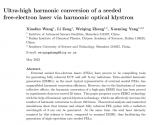Comparative Study on Microstructure of Mo/Si Multilayers Deposited on Large Curved Mirror with and without the Shadow Mask
Institute of Precision Optical Engineering, School of Physics Science and Engineering, Tongji University, Shanghai 200092, China
MOE Key Laboratory of Advanced Micro-Structured Materials, No. 1239 Siping Road, Shanghai 200092, China
Department of Physics, Shanghai University, Shanghai 200444, China
National Synchrotron Radiation Laboratory, University of Science and Technology of China, Hefei 230029, China
24 February 2023
Abstract
The Mo/Si multilayer mirror has been widely used in EUV astronomy, lithography, microscopy and other fields because of its high reflectivity at the wavelength around 13.5 nm. During the fabrication of Mo/Si multilayers on large, curved mirrors, shadow mask was a common method to precisely control the period thickness distribution. To investigate the effect of shadow mask on the microstructure of Mo/Si multilayers, we deposited a set of Mo/Si multilayers with and without the shadow mask on a curved substrate with aperture of 200 mm by direct current (DC) magnetron sputtering in this work. Grazing incidence X-ray reflectivity (GIXR), diffuse scattering, atomic force microscope (AFM) and X-ray diffraction (XRD) were used to characterize the multilayer structure and the EUV reflectivity were measured at the National Synchrotron Radiation Laboratory (NSRL) in China. By comparing the results, we found that the layer microstructure including interface width, surface roughness, layer crystallization and the reflectivity were barely affected by the mask and a high accuracy of the layer thickness gradient can be achieved.
Conclusions
The interfacial structure and the surface roughness of the Mo/Si multilayers deposited with and without a shadow mask were characterized by different test methods. With the correction of the shadow mask, the periodic thickness at each location on the whole substrate can be achieved within ±0.02 nm of the expected thickness, corresponding to ±0.3% of the expected thickness at each location. The surface roughness of the samples deposited with and without the shadow mask is the same on the whole substituted substrate, all lower than 0.2 nm. The crystalline intensity of the samples deposited with and without the shadow mask is basically the same, and the shadow mask does not affect the crystallization of the multilayers. Additionally, both samples deposited with and without the shadow mask have high reflectivity at 12–15 nm around 65%. It was found that the layer microstructure including interface width, surface roughness, layer crystallization and the reflectivity were barely affected by the mask and a high accuracy of the layer thickness gradient can be achieved. This work can provide useful guidance for the deposition of a large, curved multilayer mirror for EUV optical systems.

